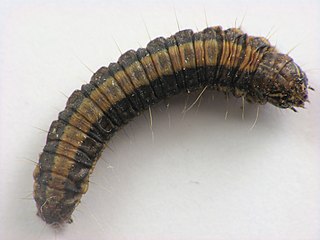
Hypena is a genus of moths in the family Erebidae. It was first described by Franz von Paula Schrank in 1802. These non-migratory moths overwinter as pupae and almost never estivate as adults.
Cryptobotys is a monotypic moth genus of the family Crambidae described by Eugene G. Munroe in 1956. Its only species, Cryptobotys zoilusalis, was described by Francis Walker in 1859. It is found in Cuba, Jamaica, Puerto Rico, Central America and the southern United States, where it has been recorded from Florida.

Palpita arsaltealis is a moth of the family Crambidae first described by Francis Walker in 1859. It is found in the north-eastern United States, south to South Carolina. It is also present in Quebec and Ontario.

The Epipaschiinae are a subfamily of snout moths. Almost 600 species are known today, which are found mainly in the tropics and subtropics. Some occur in temperate regions, but the subfamily is apparently completely absent from Europe, at least as native species. A few Epipaschiinae are crop pests that may occasionally become economically significant.

Gesonia obeditalis is a species of moth of the family Noctuidae first described by Francis Walker in 1859. It is found from eastern Africa, the Seychelles, the Maldives and the Oriental tropics of India, Sri Lanka east to the Philippines, the Sula Islands and Australia. The adult moth has brown wings with a scalloped dark brown band near the margin. The hindwings are similar in pattern to the forewings but are a paler shade of brown.

Cydalima perspectalis or the box tree moth is a species of moth of the family Crambidae, first described by Francis Walker, the English entomologist, in 1859. Native to Japan, China, Taiwan, Korea, far-east Russia and India, it has invaded Europe; first recorded in Germany in 2006, then Switzerland and the Netherlands in 2007, Great Britain in 2008, France and Austria in 2009, Hungary in 2011, then Romania, Spain and Turkey. It has been seen in Slovakia, Belgium and Croatia.

Pasiphila muscosata, the emerald pug moth, is a moth in the family Geometridae. It is endemic to New Zealand and has been found in the North, South and Stewart Islands. The larvae of this species are known to be present in January and live on Muehlenbeckia species including Muehlenbeckia australis. The larvae tends to be brown but it is variable in both colour and markings. The larvae of this species pupates in a loose cocoon on the ground and adult moths emerge in September. Adults are commonly on the wing until the following May. Although adults tend to be a deep emerald green colour this species is again variable and there is also an orange-yellow variety as well as intermediate forms. Adults are attracted to light and often rest during the day on tree trunks.
Neurophyseta laudamialis is a moth in the family Crambidae. It was described by Francis Walker in 1859. It is found in Venezuela.

Pyrausta onythesalis is a moth in the family Crambidae. It was described by Francis Walker in 1859. It is found in North America, where it has been recorded from Florida to Georgia, Iowa, Kansas, Oklahoma, Texas and Arizona.

Microtheoris ophionalis, the yellow-veined moth, is a moth in the family Crambidae. It was described by Francis Walker in 1859. It is found from southern Canada, through the United States and Mexico to South America.
Bicilia iarchasalis is a moth in the family Crambidae. It was described by Francis Walker in 1859. It is found in the south-eastern United States, where it has been recorded from Florida and Texas, as well as in Mexico, Cuba, the Dominican Republic, Puerto Rico and Venezuela.
Coptobasis opisalis is a moth in the family Crambidae. It was described by Francis Walker in 1859. It has been recorded from India.

Hypenula cacuminalis, the long-horned owlet moth, is a moth of the family Erebidae. The species was first described by Francis Walker in 1859. It is found from the south-eastern United States west to Texas and Arizona.

Prenesta scyllalis is a moth in the family Crambidae. It was described by Francis Walker in 1859. It is found in Brazil, Colombia, Peru, Costa Rica, Honduras, Belize and Mexico.

Psara dryalis is a moth in the family Crambidae. It was described by Francis Walker in 1859. It is found in the Dominican Republic, Puerto Rico, Jamaica, Cuba and from the southwestern United States to Central America.
Sufetula sunidesalis is a moth in the family Crambidae. It was described by Francis Walker in 1859. It is found on Borneo and in India, Sri Lanka and Malaysia.
Syllepte eriopisalis is a moth in the family Crambidae. It was described by Francis Walker in 1859. It is found on Borneo and in India.

Tatobotys janapalis is a moth in the family Crambidae. It was described by Francis Walker in 1859. It is found in Japan, Taiwan, Sri Lanka, India, Myanmar, Borneo, Indonesia the Solomon Islands. It is also found in Australia, where it has been recorded from Queensland and New South Wales.
Udea ialis is a moth in the family Crambidae. It was described by Francis Walker in 1859. It is found in Brazil and Bolivia.

Trachypepla conspicuella is a species of moth in the family Oecophoridae. It is endemic to New Zealand and is found in both the North and South Islands. It is similar in appearance to its close relative T. euryleucota but tends to be paler. Its colouration imitates bird droppings. Larvae feed on leaf litter. Adults of this species are on the wing from November to February and have been observed resting on fences and walls.












